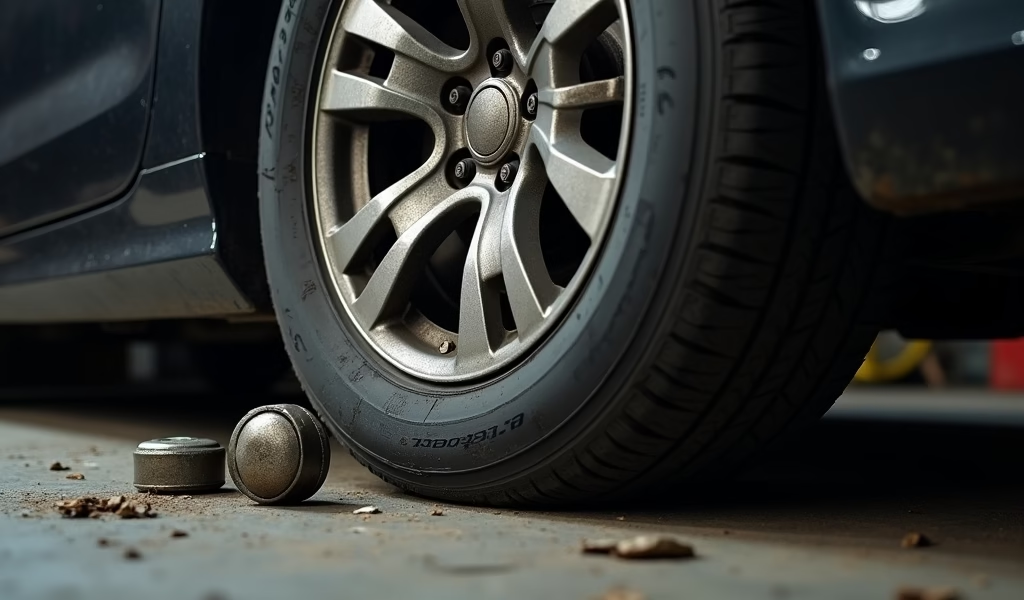Overview
This article explains wheel weight balancing tolerance and its importance for vehicle performance, providing five key tips: know your vehicle’s specific requirements, choose appropriate wheel weights, understand static vs. dynamic balancing methods, maintain regular inspections, and trust professional equipment. Proper wheel balancing within recommended tolerances (typically 5-10g for passenger vehicles, less for performance cars) prevents vibrations, extends tire life, improves fuel efficiency, and ensures safer handling at highway speeds.
Table of Contents
- Understanding Wheel Balancing and Balance Tolerances
- Why Proper Wheel Balancing Tolerances Matter
- Tip 1: Know Your Vehicle’s Specific Tolerance Requirements
- Tip 2: Choose the Right Type of Wheel Weights
- Tip 3: Understand Static vs. Dynamic Balancing
- Tip 4: Regular Maintenance and Inspection
- Tip 5: Trust Professional Equipment and Expertise
- Conclusion
- Frequently Asked Questions
Understanding Wheel Balancing and Balance Tolerances
Wheel weight balancing tolerance is one of those automotive topics that doesn’t get much spotlight until you’re experiencing that annoying steering wheel shimmy on the highway. As a professional mechanic with over 15 years in the field, I’ve seen countless vehicles come into the shop with vibration issues that all traced back to improper wheel balancing. The tolerance – that’s the acceptable margin of imbalance – can make all the difference between a smooth, comfortable ride and one that has you gripping the steering wheel with white knuckles at highway speeds.
In simple terms, wheel balancing ensures that weight is distributed evenly around your wheel and tire assembly. Every tire and wheel combination has slight weight variations that, when rotating at high speeds, can cause vibrations. Balance tolerance refers to how much imbalance is acceptable – typically measured in grams. Most passenger vehicles have tolerances ranging from 5-10 grams, though performance and luxury vehicles often require tighter tolerances of 5 grams or less.
Throughout this article, I’ll break down everything you need to know about wheel weight balancing tolerance and share five actionable tips to ensure your wheels are properly balanced for the smoothest possible ride. Whether you’re a DIY enthusiast or simply want to be more informed when talking to your mechanic, understanding these principles will help you maintain your vehicle’s performance and extend the life of your tires.
Why Proper Wheel Balancing Tolerances Matter
Have you ever noticed your steering wheel shaking like it’s had too much caffeine when you hit 55-60 mph? That’s likely a wheel balance issue, and the tolerance levels aren’t just some arbitrary number mechanics made up to charge you more. There’s real science behind getting this right.
When wheels rotate at high speeds, even small imbalances are multiplied by centrifugal force. An imbalance of just 10 grams (about the weight of two nickels) can create a noticeable vibration at highway speeds. Ignoring these tolerances can lead to several problems:
- Premature and uneven tire wear, reducing your tire life by thousands of miles
- Excessive stress on suspension components and wheel bearings
- Reduced fuel efficiency from increased rolling resistance
- Driver fatigue from constant vibration
- Decreased handling performance, especially during emergency maneuvers
I once had a customer who complained about excessive tire wear on his luxury sedan. When I checked his maintenance history, I discovered he had skipped proper wheel balancing during his last two tire rotations. The resulting imbalance caused his $1,200 set of tires to wear out in just 15,000 miles instead of their expected 50,000-mile lifespan. A $60 wheel balancing service could have saved him over $800 in premature tire replacement.
Understanding and respecting proper wheel weight balancing tolerance isn’t just about comfort—it’s about safety and significant long-term savings. Now, let’s dig into some practical tips to ensure your wheels are balanced correctly.

Tip 1: Know Your Vehicle’s Specific Tolerance Requirements
When it comes to wheel weight balancing tolerance, one size definitely doesn’t fit all. Different vehicles have different requirements, and knowing your specific vehicle’s needs is crucial for optimal performance. While most standard passenger vehicles typically allow tolerances between 5-10 grams per wheel, performance vehicles, luxury cars, and motorcycles often require much tighter tolerances.
Your vehicle’s manufacturer has spent millions on research to determine the ideal balance specifications for your particular model. These specifications take into account your vehicle’s weight distribution, suspension design, intended driving conditions, and even the tire sizes that come as original equipment.
To find your specific vehicle’s wheel weight balancing tolerance:
- Check your vehicle’s service manual (often available in digital format if you’ve misplaced the physical copy)
- Contact your dealer’s service department for manufacturer specifications
- Consult trusted online forums specific to your make and model
- Ask a specialized mechanic who regularly works on your vehicle type
I’ve worked on high-performance German vehicles that required balancing tolerances of 3 grams or less, while some heavy-duty trucks could tolerate up to 15 grams without issue. The difference directly impacts ride quality, handling, and tire longevity.
As a general rule, if you drive a luxury vehicle, a sports car, or regularly travel at highway speeds, you’ll benefit from tighter tolerances even if your manufacturer allows for higher ones. Consider requesting a maximum tolerance of 5 grams per wheel for these vehicles—your back and your tires will thank you during those long highway drives. Remember that proper driveshaft balancing procedures work hand-in-hand with wheel balancing to ensure a vibration-free ride.
Tip 2: Choose the Right Type of Wheel Weights
Not all wheel weights are created equal, and choosing the right type for your specific wheels can make a significant difference in how effectively your wheels stay balanced over time. As wheel designs have evolved, so have the options for wheel weights.
Modern vehicles use several types of wheel weights, each with its own advantages and ideal applications:
- Clip-on weights: These traditional weights clip onto the rim flange of steel wheels. They’re inexpensive and easy to install but may not be suitable for alloy wheels as they can damage the finish.
- Adhesive weights: These stick-on weights attach to the inside barrel of the wheel. They’re virtually invisible from the outside, making them ideal for alloy wheels and vehicles with aesthetic considerations.
- Hybrid solutions: Some modern balancing techniques use a combination of both styles to achieve the most precise balance with minimal weight.
Material matters too. Traditional wheel weights were made of lead, but environmental concerns have shifted the industry toward zinc and steel alternatives. These newer materials are not only better for the environment but often provide more precise balancing properties.
For vehicles with tight tolerances, I recommend asking your technician about using smaller increment weights. Instead of using a single 30-gram weight, multiple smaller weights (like three 10-gram weights) can be positioned more precisely around the wheel for better balance distribution.
I once worked on a customer’s high-end sports car that continued to have vibration issues despite multiple balancing attempts. The problem? The previous shop had been using standard clip-on weights on his premium forged wheels. By switching to high-quality adhesive weights in precise positions, we eliminated the vibration completely. His wheel weight balancing tolerance required this level of precision, and the right weights made all the difference.
Tip 3: Understand Static vs. Dynamic Balancing
When discussing wheel weight balancing tolerance, it’s crucial to understand that there are actually two distinct types of balancing methods: static and dynamic. Each addresses different aspects of wheel balance, and knowing the difference can help you ensure your vehicle receives the most appropriate service.
Static balancing is the simplest form, addressing imbalance in just one plane—think of it as balancing a pizza on your fingertip. This method corrects the heavy spot of the wheel by placing a counterweight exactly opposite to it. Static balancing primarily addresses up-and-down vibrations and was the standard method for many decades.
Dynamic balancing is more comprehensive, correcting imbalances in two planes (both vertical and lateral). This method accounts for the complex forces that occur when wheels spin at high speeds. Dynamic balancing addresses both up-and-down and side-to-side vibrations, providing a more complete solution.
Here’s why this matters for wheel weight balancing tolerance:
- Narrower wheels might achieve acceptable tolerance levels with static balancing alone
- Wider wheels (especially those 7 inches or wider) typically require dynamic balancing to meet proper tolerances
- Higher speeds amplify imbalances that may not be apparent during static-only balancing
- Dynamic balancing often requires less total weight to achieve the same or better balance
Most modern computerized wheel balancers perform dynamic balancing automatically, but not all shops use updated equipment or properly calibrated machines. For vehicles with sensitive wheel weight balancing tolerance requirements, always confirm that the shop performs true dynamic balancing.
According to research from the Society of Automotive Engineers, properly performed dynamic balancing can reduce vibration by up to 85% compared to static balancing alone, particularly at highway speeds where vibrations become most noticeable.
I recommend always requesting dynamic balancing for any modern vehicle, especially for wheels wider than 6 inches. The minimal additional cost (if any) is well worth the improved ride quality and reduced wear on suspension components.

Tip 4: Regular Maintenance and Inspection
One of the most overlooked aspects of wheel weight balancing tolerance is that it’s not a “set it and forget it” maintenance item. Even perfectly balanced wheels will gradually shift out of balance through normal driving conditions. This happens due to several factors that affect your wheel’s balance over time.
Regular tire wear naturally changes the weight distribution of your tires. As tread wears down, the mass distribution shifts, potentially creating imbalances that weren’t present when the tires were new. Additionally, wheel weights can occasionally fall off, especially in regions that use road salt or have rough road conditions.
Here’s a practical maintenance schedule I recommend to my customers:
- Have your wheels balanced whenever you rotate your tires (typically every 5,000-7,000 miles)
- Always balance wheels when installing new tires
- Consider rebalancing after hitting severe potholes or curbs
- Inspect for missing wheel weights during seasonal tire changes
- Pay attention to any new vibrations, especially those that appear at specific speeds
During your regular tire rotations, ask your technician to check not just the balance but also for related issues that can mimic balance problems. These include bent rims, out-of-round tires, and even brake rotor issues that might feel similar to balance problems.
I’ve seen countless cases where a customer ignored a minor vibration for months, only to have it progressively worsen. By the time they came in, the extended period of imbalance had caused uneven tire wear patterns that couldn’t be corrected without replacing the tires. Regular inspections would have caught the issue early, requiring only a simple rebalance instead of four new tires.
According to Tire Rack’s technical resources, proactive balancing not only improves ride comfort but can extend tire life by up to 20% through more even wear patterns. That’s significant savings for a minimal investment in regular maintenance.
Tip 5: Trust Professional Equipment and Expertise
While DIY maintenance has its place in car care, wheel balancing is one area where professional equipment truly makes a difference in achieving proper wheel weight balancing tolerance. Modern computerized wheel balancers can detect imbalances down to a fraction of a gram—precision that’s simply impossible to achieve with makeshift home methods.
Professional balancing machines don’t just measure more accurately; they also account for factors that DIY methods cannot, such as the dynamic forces at different speeds and the specific characteristics of different wheel and tire combinations. These machines typically cost $5,000-$15,000 for a reason—they’re engineering marvels designed specifically for this purpose.
When choosing a shop for wheel balancing, consider these factors:
- Ask what type of balancer they use and when it was last calibrated (should be at least quarterly)
- Inquire about their balancing tolerance standards (better shops will aim for 5g or less)
- Look for shops that use “road force” balancing for even greater precision
- Check if they clean the mounting surfaces before balancing (critical for accuracy)
- Ensure they use proper mounting techniques that don’t damage alloy wheels
Road force balancing deserves special mention for vehicles with strict tolerance requirements. This advanced technique simulates the weight of the vehicle on the tire during balancing, identifying issues that traditional balancing might miss. For luxury vehicles or those experiencing stubborn vibration issues, road force balancing can be the difference between continued problems and a perfect solution.
I once worked with a customer who had been to three different shops with complaints about highway vibrations. Each shop had balanced his wheels, yet the problem persisted. When we performed road force balancing, we discovered a manufacturing defect in one tire that created a “hard spot” that only appeared under load. This wouldn’t have been detected with standard balancing equipment, no matter how precisely the weights were applied.
For vehicles with critical wheel weight balancing tolerance requirements, the expertise of the technician matters as much as the equipment. An experienced technician knows that proper mounting, clean surfaces, and attention to detail make the difference between a mediocre balance and a perfect one.
Conclusion
Proper wheel weight balancing tolerance might seem like a minor detail in the grand scheme of vehicle maintenance, but as we’ve explored, it significantly impacts your driving experience, safety, and long-term ownership costs. The difference between properly balanced wheels within the correct tolerance range and those that are “close enough” is the difference between a smooth, confident ride and one plagued by vibrations, premature wear, and potential safety concerns.
By understanding your vehicle’s specific requirements, choosing appropriate wheel weights, recognizing the importance of dynamic balancing, maintaining regular inspection schedules, and trusting professional equipment, you’re setting yourself up for thousands of miles of smooth, vibration-free driving.
Remember that wheel weight balancing tolerance isn’t just about comfort—it’s about protecting your investment in your vehicle and tires while ensuring optimal handling characteristics. The small investment in proper balancing pays dividends in extended tire life, reduced strain on suspension components, and improved fuel efficiency.
Next time you’re at the shop for new tires or a rotation, take a moment to discuss balancing tolerances with your technician. Ask questions about their equipment, methods, and standards. A good mechanic will appreciate your interest and ensure your vehicle receives the precise attention it deserves.
Your smooth ride begins with properly balanced wheels, and now you have the knowledge to ensure yours are maintained to the highest standards possible.
Frequently Asked Questions
What is the standard wheel weight balancing tolerance for most passenger vehicles?
Most passenger vehicles have tolerances ranging from 5-10 grams per wheel. Luxury and performance vehicles often require tighter tolerances of 5 grams or less.
How often should I have my wheels balanced?
You should have your wheels balanced whenever you rotate your tires (every 5,000-7,000 miles), when installing new tires, and after hitting severe potholes. Regular balancing prevents vibration issues and extends tire life.
Can I balance my own wheels at home?
While DIY balancing methods exist, they cannot match the precision of professional computerized equipment that measures imbalances down to fractions of a gram. Professional balancing is strongly recommended for proper tolerance levels.
Does wheel weight balancing tolerance affect fuel efficiency?
Yes, properly balanced wheels within correct tolerance ranges can improve fuel efficiency by reducing rolling resistance. Unbalanced wheels create drag that forces your engine to work harder, consuming more fuel.
What’s the difference between wheel balancing and wheel alignment?
Wheel balancing addresses weight distribution around the wheel to eliminate vibrations, while alignment adjusts the angles of the wheels to ensure they’re parallel to each other and perpendicular to the ground. Both are important but separate maintenance procedures.

